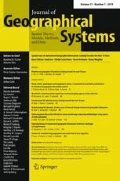Abstract.
Geographic information systems (GIS) provide a variety of tools for the manipulation and display of public health data. Few, however, enable users to interactively evaluate hypotheses on spatial trends in disease risk that may be suggested by maps of measures of disease impact. We addressed this limitation by developing a seamless interface between a commercial GIS and a suite of spatial analysis algorithms. Users of the system can utilize the GIS's capability to interactively select and manipulate geographically referenced data and, through a series of pull-down menus, apply a variety of exploratory analysis methods to this information. In the presented application, we illustrate this capability by including algorithms for the reduction of random noise in observed incidence rates, for the detection of unusual aggregations of disease events, and for the statistical evaluation of inferences drawn from spatial trends. We demonstrate this application by examining lung cancer mortality in the state of Ohio.
Similar content being viewed by others
Author information
Authors and Affiliations
Additional information
Received: 22 September 1999 / Accepted: 8 March 2000
Rights and permissions
About this article
Cite this article
Wall, P., Devine, O. Interactive analysis of the spatial distribution of disease using a geographic information systems. J Geograph Syst 2, 243–256 (2000). https://doi.org/10.1007/PL00011457
Issue Date:
DOI: https://doi.org/10.1007/PL00011457




